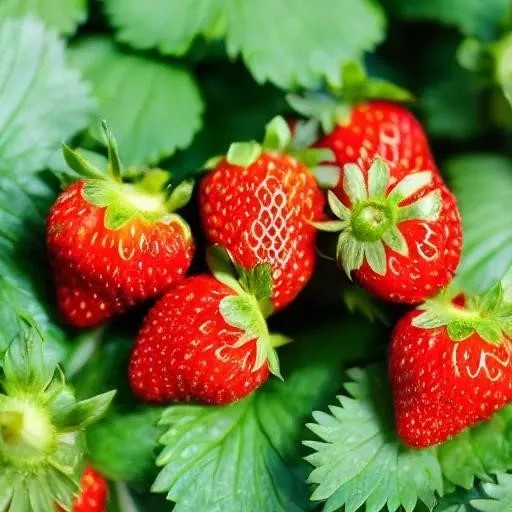There’s an undeniable magic in biting into a perfectly ripe‚ sun-warmed strawberry‚ plucked directly from your own garden. It’s a taste that transports you to childhood summers‚ a burst of sweetness far surpassing anything found in a supermarket aisle. For countless enthusiasts‚ cultivating these ruby jewels is more than just a hobby; it’s a deeply rewarding endeavor‚ promising succulent harvests and a vibrant splash of color in any landscape. Imagine transforming your backyard or even a small patio into a thriving haven for these beloved berries‚ producing an abundance of nature’s candy with remarkably little effort;
This isn’t merely a dream for seasoned horticulturists; with the right strawberries gardening hints and tips‚ anyone can achieve remarkable success. From novice gardeners to those looking to optimize their yields‚ the journey to a prolific strawberry patch is accessible and incredibly fulfilling. We’re on the cusp of a gardening revolution‚ where sustainable practices meet cutting-edge insights‚ empowering every individual to cultivate their own delicious bounty. By embracing time-tested techniques and innovative approaches‚ you’ll soon be enjoying baskets brimming with aromatic‚ homegrown goodness‚ ready for jams‚ desserts‚ or simply enjoyed fresh off the vine.
Popular Strawberry Varieties for Home Gardeners
| Variety Name | Type | Key Characteristics | Growing Tips | Reference Link |
|---|---|---|---|---|
| ‘Albion’ | Everbearing | Large‚ firm‚ conical berries; excellent flavor; disease-resistant. | Thrives in containers; consistent watering crucial for continuous fruiting. | The Old Farmer’s Almanac |
| ‘Ozark Beauty’ | Everbearing | Medium-sized‚ sweet berries; very cold hardy; good for preserves. | Adapts well to various soil types; benefits from mulching for winter protection. | Gardening Know How |
| ‘Honeoye’ | June-bearing | Early producer; medium to large‚ firm‚ bright red berries; good for freezing. | Needs well-drained soil; early spring fertilization encourages strong yields. | Bonnie Plants |
| ‘Seascape’ | Everbearing | Large‚ glossy‚ sweet berries; high yields; tolerant of heat and disease. | Excellent for hanging baskets or raised beds; regular feeding supports prolific fruiting. | |
| ‘Tristar’ | Everbearing | Medium-sized‚ intensely sweet berries; very aromatic; disease-resistant. | Ideal for small spaces; benefits from protection from birds due to sweetness. |
Cultivating Success: Essential Hints for Your Strawberry Patch
1. The Foundation: Site Selection and Soil Preparation
Like any grand architectural project‚ a flourishing strawberry patch begins with a solid foundation. Strawberries are sun-worshippers‚ demanding at least six to eight hours of direct sunlight daily to produce their sweetest fruits. Choosing a location bathed in ample light is paramount. Beyond illumination‚ soil quality plays a pivotal role. These plants thrive in well-drained‚ slightly acidic soil (pH 5.5-6.5)‚ rich in organic matter. Before planting‚ consider amending your soil with generous amounts of compost or well-rotted manure‚ ensuring optimal nutrient availability and drainage. A soil test‚ easily performed with a home kit‚ can provide invaluable insights‚ guiding your amendments for truly spectacular results.
2. Planting with Purpose: Bare-Root vs. Potted Plants
Understanding your planting material is key to a robust start. Bare-root plants‚ often dormant‚ are typically planted in early spring. Upon receiving them‚ soak their roots in water for about 20 minutes before planting. When placing them in the ground‚ ensure the crown – the point where the stem meets the roots – is precisely at soil level‚ avoiding burying it too deeply or leaving it exposed. Potted plants‚ conversely‚ offer more flexibility and can be planted throughout the growing season. Regardless of the type‚ proper spacing is critical; generally‚ 12-18 inches between plants in rows 3 feet apart allows for adequate air circulation and growth‚ curtailing disease risks and maximizing yields.
3. The Elixir of Life: Watering and Fertilization
Consistent moisture is the lifeblood of a thriving strawberry plant‚ particularly during fruiting. These shallow-rooted plants are susceptible to drought‚ which can dramatically reduce berry size and flavor. Aim for about 1 inch of water per week‚ either from rainfall or supplemental irrigation‚ ensuring the soil remains consistently moist but never waterlogged. Drip irrigation or soaker hoses are incredibly effective‚ delivering water directly to the roots while keeping foliage dry‚ a crucial step in preventing fungal diseases. When it comes to nutrients‚ a balanced fertilizer applied after planting and again after the main harvest will replenish the soil‚ fueling robust growth and future fruit production.
4. Guardians of the Garden: Pest and Disease Management
A proactive approach to pest and disease management is far more effective than a reactive one. Regularly inspecting your plants for signs of trouble‚ like chewed leaves or unusual spots‚ allows for early intervention. Common culprits include slugs‚ birds‚ and fungal diseases like powdery mildew. Employing organic strategies such as netting to deter birds‚ hand-picking slugs‚ and ensuring good air circulation around plants can significantly mitigate problems. For persistent issues‚ horticultural oils or organic fungicides can be remarkably effective. By maintaining a clean garden and practicing crop rotation‚ you’re building a resilient ecosystem‚ safeguarding your precious harvest.
5. The Sweet Reward: Harvesting and Ongoing Care
The moment of harvest is arguably the most satisfying. Pick strawberries when they are fully red‚ glossy‚ and easily detach from the plant. A gentle twist of the stem‚ leaving a small piece attached to the berry‚ will ensure maximum freshness and shelf life. Beyond harvesting‚ ongoing care is vital. Runners‚ the long stems producing new plants‚ should be managed. While some can be allowed to root to expand your patch‚ excessive runners can sap energy from the mother plant‚ reducing fruit production. Pruning spent leaves and ensuring winter protection‚ such as a layer of straw mulch‚ will prepare your plants for a strong resurgence in the following spring‚ promising years of delectable returns.
6. Advanced Cultivation: Maximizing Your Yields
For those seeking to elevate their strawberry game‚ consider advanced techniques. Vertical gardening systems‚ like strawberry towers or hanging baskets‚ are ingeniously effective for maximizing space in urban environments‚ allowing even small balconies to become productive mini-farms. Companion planting‚ integrating herbs like borage or thyme nearby‚ can deter pests naturally and enhance growth. “By integrating insights from AI-driven climate models‚” notes Dr. Anya Sharma‚ a leading horticultural scientist‚ “gardeners can now fine-tune irrigation schedules and nutrient delivery with unprecedented precision‚ truly revolutionizing home-scale agriculture.” Embracing these sophisticated strategies transforms gardening from a simple chore into a highly optimized‚ sustainable endeavor.
The Future is Sweet: A Call to Cultivate
The journey of growing strawberries is a profoundly rewarding one‚ offering not just an abundance of delicious fruit but also a deeper connection to nature’s rhythms. From the careful preparation of the soil to the joyous moment of harvest‚ each step is an affirmation of effort and patience; The future of home gardening is incredibly bright‚ filled with innovative tools and a growing community eager to share knowledge and successes. As we look ahead‚ imagine a world where every home‚ regardless of size‚ contributes to a greener‚ more self-sufficient planet‚ one sweet‚ succulent strawberry at a time. So‚ roll up your sleeves‚ embrace these invaluable hints‚ and embark on your own strawberry adventure – a truly vibrant‚ delicious future awaits!






